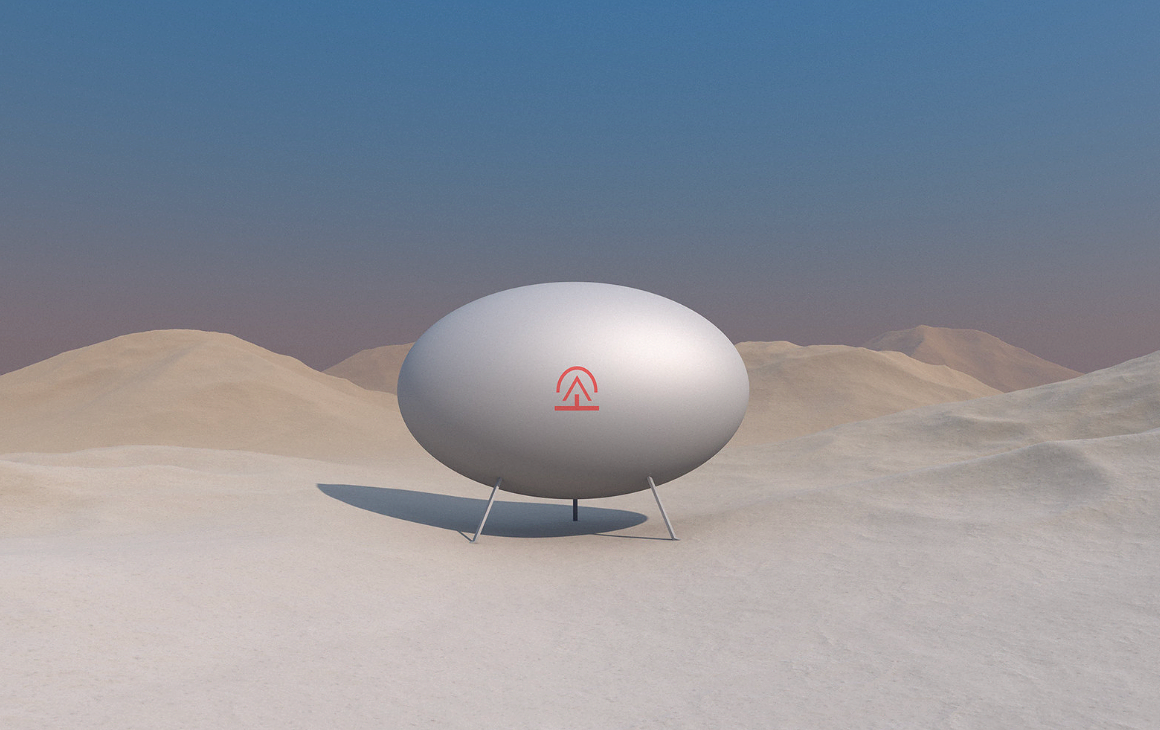
The Socorro UAP incident (also known as the Lonnie Zamora Incident) involves the sighting of a landed aerial vehicle of unknown origin and its occupants by policeman Lonnie Zamora near Socorro, New Mexico, on the afternoon of Friday, April 24, 1964. The incident is widely regarded as one of the best UAP close encounters ever documented and was logged among the many unidentified cases investigated by the United States Air Force’s Project Blue Book.
Background
Socorro is the county seat of Socorro County, New Mexico. The town is located just to the northeast of White Sands Missile Range, the location of the first atomic bomb test in 1945 (then called the Trinity Site). Since 1889 with the establishment of the New Mexico School of Mines (since renamed the New Mexico Institute of Mining and Technology, or New Mexico Tech), Socorro has been a hub for science and technology education.¹
Dionicio E. “Lonnie” Zamora, a New Mexico native, was born in Magdalena on September 7, 1933, to parents Domingo and Rafelita Zamora.² Prior to his entry into law enforcement, Lonnie was an employee at New Mexico Tech, working in the university’s machine shop.³ At the time of the UAP incident, he had been serving as an officer with the Socorro Police Department for five years.⁴
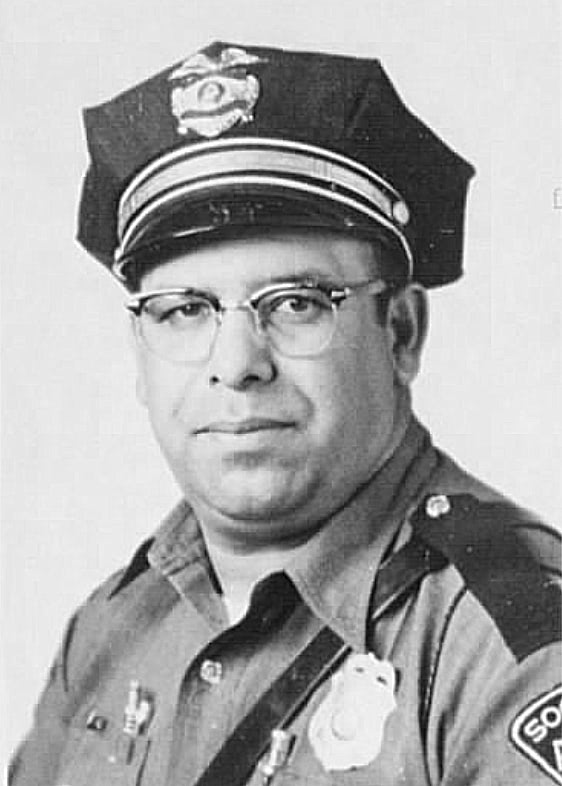
Initial UAP Observation and Pursuit
At around 5:45 P.M. on April 24, 1964, Socorro PD officer Lonnie Zamora was traveling due south on Park Street west in his patrol car, a white 1964 Pontiac, near the Socorro Court House when he observed a black Chevrolet approximately three blocks ahead of him exceeding the speed limit. Zamora began to pursue the vehicle, whose driver appeared to be a young man in his late teens heading in the direction of the town rodeo grounds.
Zamora was still a few blocks away from the black Chevrolet when he became aware of a loud, rumbling “roar” and, looking to the southwest, observed, “a flame in the sky” at an estimated distance of half a mile away. Zamora would later describe this flame in a written account of his observations provided to Project Blue Book as being “bluish and sort of orange too,” and although he could not gauge its size, he said it was a “narrow type of flame” that increased slightly in width from top to bottom.
As he drove, Zamora watched through the open window of his Pontiac as the light slowly descended. Although he had been wearing green sunglasses over his normal prescription lenses at the time of the first observation, the sun’s position to the west nonetheless made it difficult for Lonnie to make out further details about what might be producing the flame.
As the light continued its descent, it became partially obstructed by a hill a short distance away. At this time, Zamora recalled there being some “commotion” as dust appeared to be rising near where the flame disappeared beyond the hill, although he noted strong winds on this otherwise clear afternoon might have accounted for this. Aware of a small building used for the storage of explosives in the same general direction, Zamora became concerned that the loud noise and flame he had witnessed might have come from this area and abandoned the car chase to go investigate.
Zamora turned onto a gravel road that went up the hill in the direction of the loud noise, which he described as a “roar, not a blast.” The rough terrain slowed Zamora’s progress, requiring him to back up and try several times before successfully making his way up the gravel road. Even as his vehicle lost traction on a few occasions, Zamora could hear the loud roaring nearby. Unlike the sound of a jet, Zamora noted that the pitch changed “from high frequency to low frequency,” and he was able to hear it for what he judged to be ten seconds before it finally stopped. While the noise persisted, Zamora said he was also able to see the flame in the distance. Once Zamora’s vehicle finally overcame the obstacles in its ascent up the hill, both the flame and the loud noise were gone.
Cresting the top of the hill, Zamora proceeded toward the west attempting to locate the dynamite shack when he spotted a shiny object approximately 150 to 200 yards away to the south. Zamora stopped his car and looked, initially thinking he had been observing an overturned vehicle, but it soon became evident he was looking at a round object with an exterior “like aluminum” that Zamora said appeared “whitish against the mesa background, but not chrome.”⁵
The Occupants
While stopped on the gravel road observing the object, Zamora also saw what he described as “two people in white coveralls” standing near it. According to Zamora’s report, “One of these persons seemed to turn and look straight at my car and seemed startled.”
Zamora could make out few details apart from their humanoid shape and light-colored attire. “I don't recall noting any particular shape or possibly any hats, or headgear,” Lonnie would later recall. “These persons appeared normal in shape,” he said, noting their short stature, adding that “possibly they were small adults or large kids.” This would be the only time Zamora recalled being able to see these individuals, an observation that lasted for only a few seconds while his vehicle was stopped. Sensing these individuals might be in trouble, Zamora began to drive quickly in the direction of the object.

As he proceeded along the gravel road, still believing the object he had seen was an overturned car, Zamora contacted the sheriff’s office on his radio, alerting them about a “possible 10-44 (accident)” and that he would soon “be 10-6 (busy),” as he had expected to be out of the car providing assistance. Zamora recalled saying during his call that he would be “checking the car down in the arroyo,” and was still on the radio when he arrived at the location along the road nearest to the object. Stopping the car, he noted that his radio microphone fell and that he replaced it in the radio microphone slot before exiting his vehicle, with the intention of proceeding in the direction of the object in the arroyo below him. At this time, Zamora recalled hearing a pair of loud “thumps” that he said was “like someone possibly hammering or shutting a door.”
UAP Appearance and Flight Characteristics
Almost immediately upon exiting his vehicle, Zamora said the roaring noise resumed which, at his present position much closer to the object, was now extremely loud. The tone of the roar began to change like before, although this time from low to high and increasing in volume. Zamora also noticed the flame again at this time, which he could now see was underneath the object. By now, it was evident to Zamora the object was no overturned car, as it slowly began to rise into the air.

The flame produced by the craft appeared light blue at this point, becoming an orange color toward the bottom. Zamora was unsure about the exact location where the flame emerged from the object, although it appeared to be produced from someplace on its underside, and there was no smoke. As it steadily rose, Zamora could now see the side of the object, which he said, “was oval in shape” and possessed a smooth, featureless surface with no windows or other openings, although “red lettering of some type” was visible on the side of the craft, which Zamora compared to an insignia “about 2 ½' high and about 2' wide.”
Once the object began producing the roaring and flames, Zamora began to run in the direction of his vehicle, attempting to continue observing the object. As he approached the vehicle, his leg collided with the car’s back fender, causing his glasses to fall to the ground. Zamora did not retrieve them at this point, instead moving toward the rear of the vehicle, placing it between him and the object. He continued to run toward the north, looking back to watch the object on at least two occasions.
From its position within the arroyo where the object had been resting, it had now risen to approximately the same height as the patrol car. Zamora, now approximately 50 feet from his vehicle just across the crest of the hill, had stopped when the loud roaring sound, which had frightened him, finally ceased. From his position near the hilltop, Zamora ducked down, initially shielding his face with his arms, but then looked up and watched the object as it traveled away from him maintaining a height of 10 to 15 feet off the ground. Moving in the direction of the dynamite shack, Zamora judged that it cleared the top of the eight-foot-tall structure “by about three feet.”
The object was moving very quickly as it made its departure, rising and taking off “immediately across the country.” Zamora ran back down the hill toward his patrol car. Watching the object continuously, he stopped to pick up his glasses and entered the vehicle, calling radio operator Nep Lopez and advising him to look out his window to see if he “could see an object,” describing that it “looks like a balloon.” At this point, there was no flame, smoke, or sound produced by the object, and Zamora continued watching as it disappeared once it flew over Box Canyon or Six Mile Canyon Mountain in the distance. Zamora later guessed that his total time spent observing the object at close range (from the second time he stopped his vehicle until it disappeared) had been roughly 20 seconds.⁶
Police Investigation
Zamora gave Lopez directions to his location over the radio, and while awaiting the arrival of Sergeant M.S. Chavez, he proceeded into the arroyo toward the apparent landing site, discovering several areas where vegetation appeared to be burning. “The persons were not seen when I drove to the scene area,” Zamora said of the two individuals clad in white. Just prior to Chavez’s arrival, Zamora also drew a sketch of what he recalled the insignia on the object had looked like.
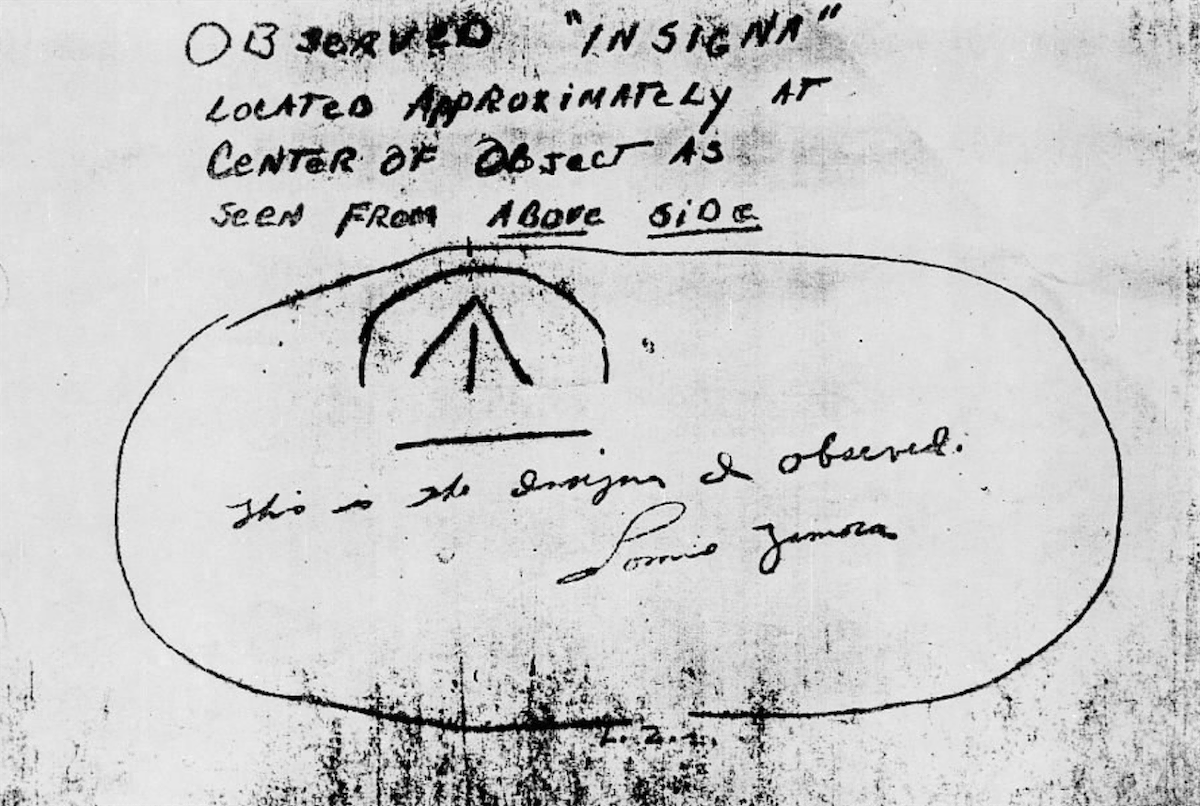
Zamora noted that the last time he had alcohol had been more than a month beforehand and that otherwise, he was in good health. Nonetheless, once Chavez arrived, he found Zamora sweating and “very pale.” Returning with Zamora to the landing site, the two officers observed the burning brush, and Chavez also pointed out what appeared to be tracks left on the ground. Zamora believed these had been left by what appeared to be legs protruding from the object's base.⁷ The four primary depressions were each trapezoidal shapes roughly 12-16 inches in length by 6-8 inches in width. A smaller set of four depressions found to one side were speculated to have been where a ladder may have first been placed, then moved to offer a better grip.
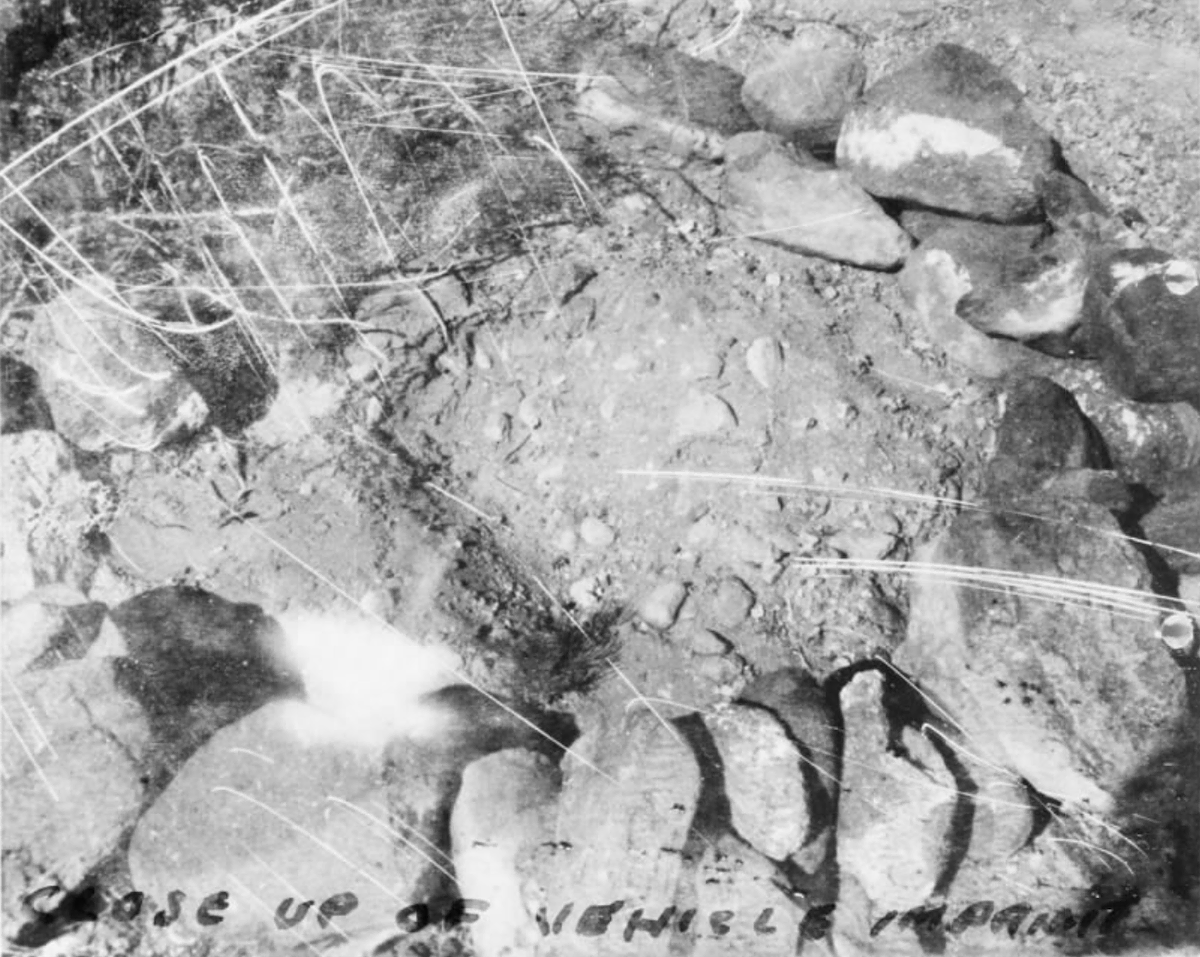
While the two were at the scene, Chavez even checked Zamora’s car for any equipment that could have possibly been used to stage the markings and burnt areas at the purported landing site. Soon, two more officers, Undersheriff James Luckie and State Police Patrolman Ted V. Jordan arrived at the scene along with Robert White, a cattle inspector who had overheard Zamora’s excited calls on the radio only minutes earlier. Jordan took several photographs of the area with his Argus C-3 camera, and shortly before 7 P.M., Chavez and Zamora finally left and went to the state police headquarters.⁸
Military and Civilian Inquiries
Shortly after Chavez and Zamora arrived, an FBI agent named Arthur Byrnes Jr., also having overheard police radio chatter about the incident, briefly spoke to Zamora, after which he called White Sands and spoke to Army Captain Richard T. Holder, the senior military officer in the area at that time. Holder thereafter arrived at police headquarters, and after a short interview with Zamora and agent Byrnes, the three were accompanied by several Socorro police officers as they traveled back to the landing site.
Holder then made inquiries with White Sands and Holloman Air Force Base about whether Zamora could have seen an experimental aircraft and thereafter confirmed to the local Socorro newspaper that neither had such a device. Later that evening, Holder and several military police from nearby Stallion station cordoned off the landing site. The following morning, Holder purportedly received a phone call from a man identifying himself as a colonel calling from the Joint Chiefs of Staff, who ordered him to read a report he had prepared on the incident into the scrambler, prompting the young officer—then just 28—to wonder why the Pentagon had taken such interest in Zamora’s sighting.
By Sunday, Project Blue Book investigator and chief analyst T/Sgt. David Moody had arrived in Socorro, as had Major William Conner, a Kirtland AFB officer tasked with handling UFO reporting. Civilian researchers Jim and Coral Lorenzen of the Phoenix-based Aerial Phenomena Research Organization (APRO) had also arrived on the scene, along with several others who had flocked to the area following the story of Zamora’s UAP encounter making headlines in newspapers across the country. The following Tuesday, Ray Stanford, an investigator with the National Investigations Committee on Aerial Phenomena (NICAP) also arrived. Finally, later that same day J. Allen Hynek, then scientific advisor to Project Blue Book, was alerted about the case by the project’s director, Captain Hector Quintanilla, and soon afterward was on a plane bound for New Mexico.⁹
Hynek’s Investigation
Hynek was met by Major Connor once he arrived in New Mexico, and on the way to Socorro, a flat tire resulted in the scientist hitchhiking his way to the scene of the incident. Once he finally arrived and met Zamora and Chavez, he found them “very anti-AF”, having received a negative impression from their interactions with Air Force personnel throughout the last several days. The officers gradually warmed up to Hynek that evening and related their account, taking him to the landing site and reenacting their experience the following morning. NICAP investigator Ray Stanford was already present once they arrived and was able to assist Hynek in the collection of samples at the scene.¹⁰

Later that day Walter Shrode, a reporter with KSRC Radio in Socorro who had interviewed Zamora one day after the incident, came and spoke with Hynek in his hotel room. In the earlier interview with Zamora, the officer had seemed reluctant to characterize the two individuals he observed clad in white as people, telling Strode that he just “saw something white… white coveralls, that’s all I can say,” adding moments later that “the white object turned and saw me.”¹¹ During Shrode’s conversation with Hynek (recorded by Stanford, who was also present along with several Air Force personnel), Hynek said that Zamora told him “nothing about having seen any people,” although noting that he had specifically asked the officer about this.
Hynek also dispelled earlier assertions made by Zamora during the interview with Shrode that he had been advised not to speak about the insignia he observed on the craft. “Zamora tells me that no one—Air Force or no one else—told him not to say anything about it,” Hynek told Shrode, characterizing the insignia, as per Zamora’s description of it, as “an inverted V with a sort of a bar across it,” which Hynek compared to a marking left by a cattle brand.¹²
Although initially entertaining the possibility of an elaborate hoax, Hynek eventually became convinced that Zamora’s account was a factual retelling of events, having revisited Socorro again later that year to conduct follow-up interviews. Writing to astronomer Donald Menzel in September 1964, Hynek stated that he believed “this case may be the ‘Rosetta stone’,” and that there had “never been a strong case with so unimpeachable a witness.”¹³
Project Blue Book’s Conclusions
A brief report on the incident was issued by the Air Force on June 8, 1964. Although stating that Project Blue Book’s investigation was still open at the time the report was issued, it presented several preliminary conclusions. Among these had been that there were no additional witnesses to the event and that no unidentified helicopters or other aircraft were determined to have been in the area at the time. There were also no instances where radar detections of unusual objects had been logged, nor any meteorological activity in the area at the time that might account for what Zamora observed. The report also stated that “no foreign material or radiation above normal for the surrounding area” was found from lab analysis of soil samples collected at the landing site, nor anything indicating a means of propulsion. “There was no evidence presented that the object was extraterrestrial in origin or represented a threat to the security of the United States,” the report added.
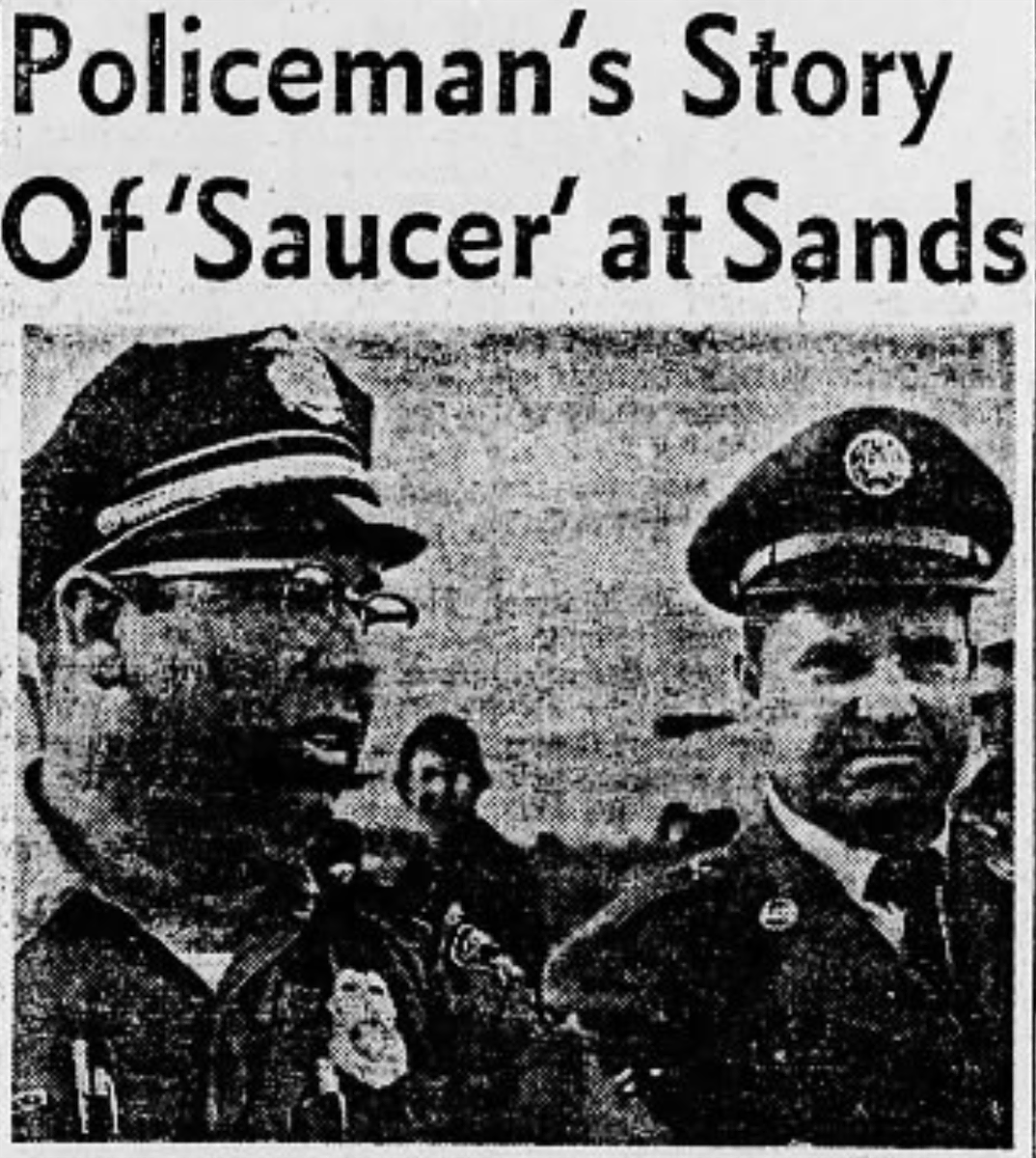
The Air Force also made inquiries about the possibility that Zamora had witnessed part of a test involving a lunar landing module. “Fifteen letters were written to industrial companies asking them for their research status on lunar landing modules,” read the report, which added that such inquiries “had not been useful” in determining what Zamora saw, but that investigators believed “tenant organizations at Holloman hold key to sighting.”¹⁴ However, no conclusive evidence linking the incident to a test vehicle of any kind ever surfaced.
Other Witnesses
Zamora initially believed himself to have been the only witness, noting that the driver of the black Chevy he had been pursuing minutes prior to his encounter might have been able to hear the loud roaring noise, but that the hillside would have likely prevented this individual from seeing the bright flame at that time. Radio operator Nep Lopez had also been unable to observe the object from a window at the sheriff’s department, although later that evening he reportedly told Zamora and others that he received three calls from area locals who claimed to have seen the descending flame coinciding with Zamora’s observation.
During Hynek’s visits to Socorro, he learned of a possible sighting by a man and his family who had stopped at the Whiting Brothers’ service station, where they spoke to Opal Grinder, the manager. According to Grinder, the man exclaimed that “Your aircraft sure fly low around here,” going on to state that a plane “almost took the roof off our car” as it passed over them. The man also said his family observed a police car pulling off the main highway at the time.
Researcher Ray Stanford also spoke with two Socorro residents who said that they and several others heard the loud roar Zamora described, also writing an account of a man called an Albuquerque television station and described seeing an oval-shaped object flying at roughly the same speed as a helicopter shortly before 5:30 P.M. the date of Zamora’s sighting. An additional sighting of a strange blue and orange light that coincided with vehicle interference was reported later that evening by a master sergeant south of Stallion Range Center at White Sands. At the time of the Air Force’s investigations, Hynek said he had tried to encourage a search for additional witnesses, which garnered “no interest whatsoever” from Project Blue Book personnel.¹⁵
Theories
In correspondence with Hynek, astronomer Donald Menzel proposed that the incident had been a hoax involving a balloon and various other elements aimed at fooling Zamora.¹⁶ With a copy of Menzel’s letter in hand, Hynek presented this theory to several Socorro residents during a subsequent trip back to the location. Among these had been Sgt. Chavez, who reportedly responded, “that Menzel should have been a science fiction writer.” Hynek expressed the view that “This is entirely too big a hoax for high school students to perpetrate.”¹⁷
Noted skeptic Phillip J. Klass initially proposed that Zamora had observed an atmospheric phenomenon akin to ball lightning, but later implied that Zamora might have been complicit in a hoax with the town mayor, Holm Bursum Jr, to generate tourism. Klass offered no evidence in support of this assertion.¹⁸
Scientist and software engineer David E. Thomas has speculated that Zamora saw a Surveyor lunar landing module prototype being carried by a Bell helicopter, in contrast with Project Blue Book’s assertions that no tests involving experimental craft of any kind were positively linked to the incident.¹⁹ However, skeptic Brian Dunning has expressed doubts about the lunar lander theory, arguing instead that Zamora might have been the target of a prank orchestrated by students at New Mexico Tech. Dunning cites a letter uncovered in the files of chemist Linus Pauling from 1968, where in correspondence with Stirling Colgate, then President of New Mexico Tech, the latter had written in a postscript that “I have good indication of student who engineered hoax. Student has left.”²⁰
In a December 2017 email to David Thomas, New Mexico Tech alumni Kevin Ashley said he had spoken to a former mining engineering student in the early 1980s who, enrolled at the time of the incident, claimed that he and another student had been igniting dynamite in the arroyo under an overturned metal barrel which propelled it into the air and thereby drew Zamora’s attention. Fearing they would be expelled, the individual claimed he and the other student fled the scene, but that they had been the individuals in white coveralls Zamora observed as he arrived.²¹

In the first volume of his published journals, Forbidden Science, scientist and venture capitalist Jacques Vallee noted the similarity between Zamora’s description of the insignia he observed on the side of the UAP and a logo that accompanied a 1961 advertisement for Astropower Inc., a subsidiary of Douglas Aircraft Company. Below the logo, the advertisement asserted the company was founded “To develop advanced propulsion systems and power equipment for tomorrow’s space vehicles.”²² More recently, Vallee has compared the Socorro craft and its diminutive occupants with a similar landing case at Valensole, France in 1965, and the purported crash of an exotic aircraft near San Antonito, New Mexico, in 1945.²³
Aftermath
Hector Quintanilla, director of Project Blue Book at the time of the incident, initially implied in a statement that the object had been some variety of experimental U.S. aircraft. However, in the absence of any evidence to support this assertion, the Socorro incident was later simply designated one of the many “Unidentified” cases in Project Blue Book’s investigations. Quintanilla, writing for the CIA journal Studies in Intelligence in 1966, went on to call Zamora’s observation “the best-documented case on record,” adding that “we have been unable, in spite of thorough investigation, to find the vehicle or other stimulus that scared Zamora to the point of panic.”
In a 1975 memoir of his years with Project Blue Book, Quintanilla expressed dissatisfaction over the way UFO proponents interpreted the Socorro incident’s classification at the time. “Although I labeled the case ‘Unidentified’ I've never been satisfied with that classification,” Quintanilla wrote. “I've always felt that too many essential elements of the case were missing. These are the intangible elements which are impossible to check, so the solution to this case could very well be lying dormant in Lonnie Zamora's head.”²⁴
To date, no conclusive explanation for Zamora’s observation has ever surfaced.